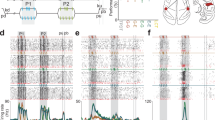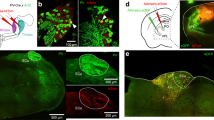Abstract
The somatosensory cortex of adult mammals has been shown to have a capacity to reorganize when inputs are removed by cutting afferent nerves or amputating a part of the body1–7. The area of cortex that would normally respond to stimulation of the missing input can become responsive to inputs from other parts of the body surface. Although a few animals have been studied with repeat recording1,2, no attempt has been made to follow the time-course of changes at cortical loci and the immediate effects of a small amputation have not been reported. We have followed the changes in response in the primary somatosensory cortex in the flying-fox following amputation of the single exposed digit on the forelimb. Immediately after amputation, neurons in the area of cortex receiving inputs from the missing digit were not silent but responded to stimulation of adjoining regions of the digit, hand, arm and wing. In the week following amputation, the enlarged receptive fields shrank until they covered only the skin around the amputation wound. The immediate response is interpreted as a removal of inhibition and the subsequent shrinking of the field may be due to re-establishment of the inhibitory balance in the affected cortex and its inputs.
This is a preview of subscription content, access via your institution
Access options
Subscribe to this journal
Receive 51 print issues and online access
$199.00 per year
only $3.90 per issue
Buy this article
- Purchase on Springer Link
- Instant access to full article PDF
Prices may be subject to local taxes which are calculated during checkout
Similar content being viewed by others
References
Merzenich, M. M. et al. Neuroscience 10, 639–665 (1983).
Merzenich, M. M. et al. J. comp. Neurol. 224, 591–605 (1984).
Franck, J. I. Brain Res. 186, 458–462 (1980).
Rasmusson, D. D. J. comp. Neurol. 205, 313–326 (1982).
Kelahan, A. M. & Doetsch, G. S. Somatosensory Res. 2, 49–81 (1984).
Wall, J. T. & Cusick, C. G. J. Neurosci. 4, 1499–1515 (1984).
Kalaska, J. & Pomeranz, B. J. Neurophysiol. 42, 618–633 (1979).
Calford, M. B., Graydon, M. N., Huerta, M. F., Kaas, J. H. & Pettigrew, J. D. Nature 313, 477–479 (1985).
Dykes, R. W. Brain Res. Rev. 6, 57–115 (1983).
Jänig, W., Schoultz, T. & Spencer, W. A. J. Neurophysiol 40, 822–835 (1977).
Jänig, W., Spencer, W. A. & Younkin, S. G. J. Neurophysiol. 42, 1450–1460 (1979).
Laskin, S. E. & Spencer, W. A. J. Neurophysiol 42, 1061–1082 (1979).
Hicks, T. P. & Dykes, R. W. Brain Res. 274, 160–164 (1983).
Metzler, J. & Marks, P. S. Brain Res. 177, 379–383 (1979).
Meizenich, M. M. et al. J. comp. Neurol. 258, 281–296 (1987).
Author information
Authors and Affiliations
Rights and permissions
About this article
Cite this article
Calford, M., Tweedale, R. Immediate and chronic changes in responses of somatosensory cortex in adult flying-fox after digit amputation. Nature 332, 446–448 (1988). https://doi.org/10.1038/332446a0
Received:
Accepted:
Issue Date:
DOI: https://doi.org/10.1038/332446a0
Comments
By submitting a comment you agree to abide by our Terms and Community Guidelines. If you find something abusive or that does not comply with our terms or guidelines please flag it as inappropriate.



